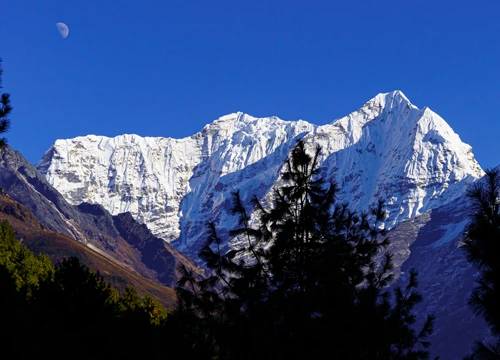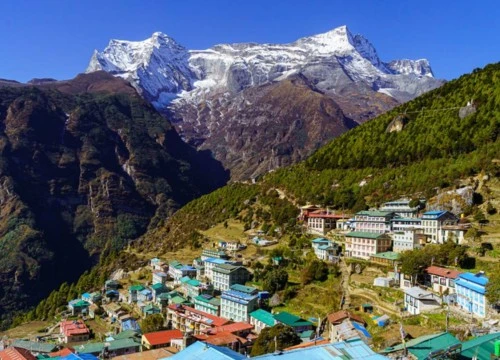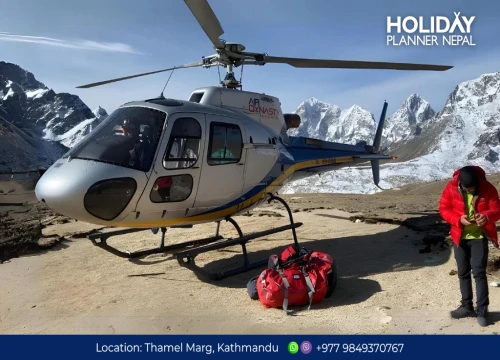Introduction: Everest Base Camp Short Trek
Everest Base Camp is a lifelong dream of trekkers and travel enthusiasts from all over the world. Everest Base Camp is the most famous destination in Nepal and is the backbone of tourism in the country. famous in Nepal since its first ascent in 1953. The trekking trail to Everest Base Camp has been widely developed, and the facilities and infrastructure have been astonishingly improved throughout the year. Immerse yourself in the rich culture of the Sherpa people. Visit ancient monasteries, witness traditional ceremonies, and engage with the warm-hearted locals along the way.
Everest Base Camp short trek is a carefully curated expedition designed for those with limited time, offering a condensed but no less captivating experience of the world's highest peaks. With expert guidance and strategic acclimatization, you'll journey through captivating landscapes, explore vibrant Sherpa villages, and witness the grandeur of Mount Everest.
Traverse through enchanting forests, picturesque Sherpa villages, and rugged terrain. Witness jaw-dropping panoramas of towering peaks, including the majestic Mount Everest. Immerse yourself in the unique Sherpa culture. Visit ancient monasteries, witness traditional ceremonies, and engage with the warm-hearted locals along the way. Savor a diverse array of dishes, from local Nepali specialties like dal bhat to international comfort food. The culinary journey is a delightful part of the trek.
Holiday Tours Nepal prioritizes your safety and comfort. The itinerary includes strategic acclimatization days in Namche Bazaar and Dingboche, ensuring a gradual ascent to higher altitudes.
Plan your Everest short trek and anticipate an unforgettable journey led by Holiday Tours Nepal. Be prepared to make lifelong memories, forge new friendships, and stand in awe of the world's highest peaks.
Take the first step towards this extraordinary adventure and let us be your trusted companion on the path to Everest Base Camp. Embrace the challenge, immerse yourself in the culture, and let the Himalayas leave an indelible mark on your soul.
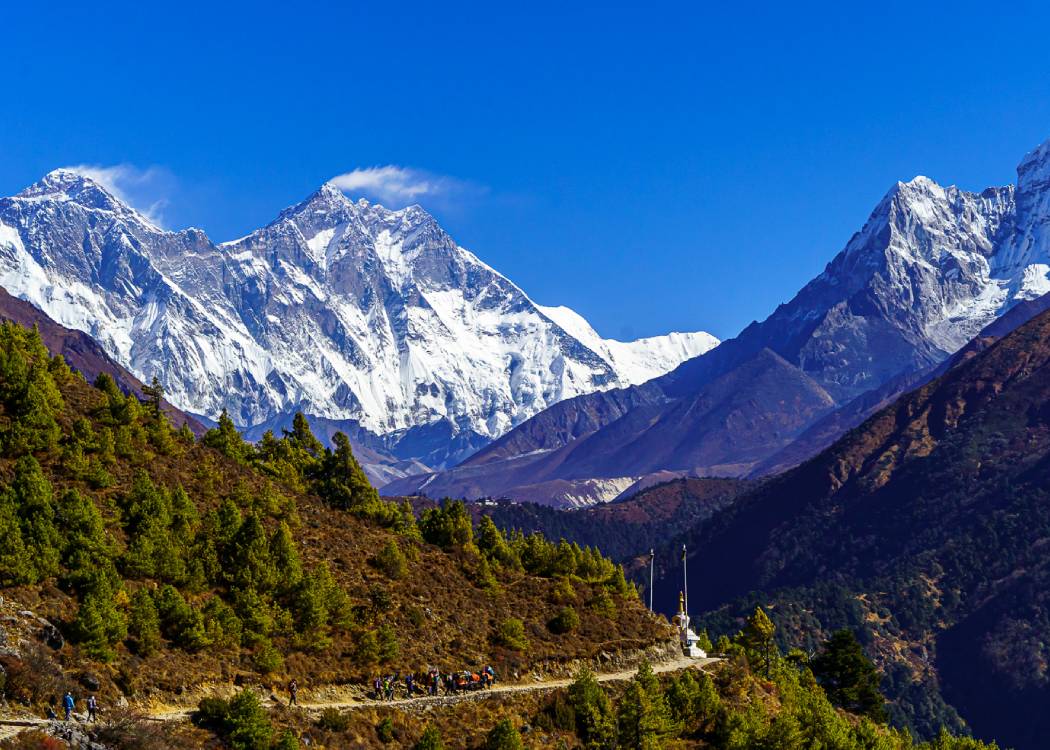
Everest Base Camp Short Trek Itinerary
Day | Activity | Altitude (m/ft) | Distance (km/miles) | Duration (hours) | Elevation Gain/Loss |
01 | Flight to Lukla and trek to Phakding . | 2,860m/9,383ft 2,610m/8,560ft | ~7.4 km / 4.6 miles | ~3-4 hrs walk | +260m / +853ft |
02 | Trek to Namche Bazaar . | 3,440m/11,286ft | ~12 km / 7.5 miles | ~5-6 hrs walk | +830m / +2,723ft |
03 | Acclimatization day at Namche Bazaar, hike to Everest View Hotel . | 3,880m/12,730ft | ~4 km / 2.5 miles (hike) | ~2-3 hrs hike | +440m / +1,444ft (hike) |
04 | Trek to Tengboche . | 3,860m/12,664ft | ~10.5 km / 6.5 miles | ~4-5 hrs walk | +420m / +1,378ft |
05 | Trek to Dingboche . | 4,410m/14,470ft | ~11 km / 6.8 miles | ~4-5 hrs walk | +550m / +1,805ft |
06 | Acclimatization day at Dingboche, hike to Nangkartshang Peak . | 5,083m/16,676ft | ~3.5 km / 2.2 miles (hike) | ~3-4 hrs hike | +673m / +2,207ft (hike) |
07 | Trek to Lobuche . | 4,940m/16,210ft | ~8.5 km / 5.3 miles | ~5-6 hrs walk | +530m / +1,738ft |
08 | Trek to Gorakshep , visit Everest Base Camp , and return to Gorakshep. | 5,180m/16,995ft | ~13 km / 8 miles | ~6-7 hrs walk | +424m / +1,391ft |
09 | Hike to Kala Patthar and trek to Pheriche . | 5,545m/18,193ft | ~15 km / 9.3 miles | ~7-8 hrs walk | +365m / +1,198ft |
10 | Trek to Namche Bazaar. | 3,440m/11,286ft | ~15 km / 9.3 miles | ~6-7 hrs walk | -840m / -2,756ft |
11 | Trek to Lukla . | 2,860m/9,383ft | ~19 km / 11.8 miles | ~6-7 hrs walk | -600m / -1,968ft |
12 | Fly back to Kathmandu. | 1,350m/4,430ft | ~30 min flight | ~30 min drive | -1,490m / -4,889ft |
From where does Everest Base Camp trek begin and end?
Trekking to Everest Base Camp begins with a scenic flight to Lukla from Kathmandu, which itself is an adventure, and the trek continues to Phakding, where we spend the first night. On the second day, we trek from Phakding to Namche Bazaar, which is the best town in the Everest Region. On the third day, we take a short walk up to the Everest View Hotel to experience how our body would react after an additional 300–500 meters. After resting and acclimatizing, our fourth day begins with a walk towards Tengboche village, where we will meditate if we reach Tengboche at the correct time. For this reason, starting early is recommended. The fifth day begins with a walk towards Dingboche from Tengboche village, which is around 4410 meters above sea level.
The sixth day is a rest and acclamation day with a short hike towards Nangkartshang, which will be around 200–300 meters of elevation gain, to check how our body would feel at 4500 meters plus. On the 7th day, we begin our day with a trek towards Lobuche village, crossing the steps of Thukla and walking through the memorial hill of the Everest Region. The 8th day is the big day. Today we go from Lobuche towards Gorakshep, check in at the hotel, have some lunch, and then go towards Everest Base Camp. After reaching the base camp, we came back down to Gorakshep to spend the night.
The 9th day begins with a walk towards Lobuche and ends in Pheriche, or Pangboche, from Gorakshep. On the 10th day, we go towards Namche Bazaar from Pheriche or Pangboche and finally have a good dinner and lunch. On the 11th day of the trip, we go towards Lukla from Namche Bazaar and celebrate our achievement of successfully completing the Everest Base Camp Trip.
On the 12th day, we fly back to Kathmandu from Lukla and spend the night in Kathmandu, where our journey ends.
Why Holiday Planner Nepal for Everest base camp short trek?
Short trekking to Everest Base Camp with Holiday Tours in Nepal is a must because of the following reasons:
- We provide all-inclusive services with no hidden costs.
- Travelers and trekkers pay for the services they select.
- Custom-tailored items mean our customers won't have to compulsorily take the package.
- Wide range of add-ons for comfort at the add-on selections.
- An open system to handpick all the little things, from food and porters to accommodations and other additional services and activities.
- The best price is guaranteed with award-winning and professional service for Everest Base Camp.

What is the best time or month for Everest base camp short trek?
The best time to go on a trek toward Everest is September, October, and November, or March, April, and May. During this period, the sky is clear, the weather is ideal, and the temperature is ideal to travel and trek towards Everest Base Camp.
The weather is ideal and vastly better compared to the winter and the monsoon season when the temperature is freezing and it's constantly raining, the flights don’t happen on time, and the views of the mountains get blocked by the thick fog.
The temperature ranges from 5 to 12 degrees Celsius (41°F to 53.6°F) during the day and drops off as we go higher, and it ranges from -5 to 5 degrees Celsius( 23°F to 41°F ) during the night.
Spring and autumn are the peak seasons for trekking in the Everest Region, and we find travelers from all around the world coming and visiting Nepal. During spring and autumn, due to the flow of travelers and trekkers, better food services are available due to the availability of groceries. The accommodation facilities can be packed, so booking your trek in advance is necessary while trekking to Everest Base Camp.
Note: Holiday Tours Nepal provides all-time updates on the weather and climatic conditions on the Everest Trekking Trail and books the accommodation in advance once the booking for the Everest Base Camp Short Trek is made.

How to prepare for Everest Base Camp short trek?
Holiday Tours Nepal has prepared a short list that, if followed, will help in completing the Everest Base Camp trip safely and successfully.
Physical Fitness
- Start preparing well in advance. Aim for at least 2–3 months of regular exercise or jogging.
- Focus on cardiovascular activities like hiking, running, cycling, and stair climbing.
- Strengthen your legs, core, and upper body with exercises like squats, lunges, planks, and push-ups.
- Incorporate uphill and downhill walking into your training to simulate trekking conditions, and try to use stairs instead of lifts.
Mental Preparation
- Be mentally prepared for the challenges of high-altitude trekking.
- Altitude sickness is a real concern, so it's important to be aware and know how to respond.
Altitude Acclimatization
- Acclimatize properly to reduce the risk of altitude sickness.
- Spend a day extra in Namche Bazaar (3,440m/11,286.09ft) to adjust and then continue to higher elevation.
- It's recommended to do side trips to places like Khumjung, Everest View Hotel, or Everest Panorama Hotel to get an experience above 3500 m/11482 ft.
- It's recommended to stay an extra day in Dingboche it is at an altitude of 4410 m/ 14,468 ft so hike to Nangkartshang to check how your feel above 4500m.
Training Hikes
- Before your trek, try to go on a few practice hikes, especially if you live in a flat area.
- Gradually increase the duration and elevation gain of these hikes to simulate trekking conditions.
- Try avoiding lifts and using stairs if you don’t have time for going on hikes, try carrying some weight on the stairs.
Nutrition and Hydration
- Eat a balanced diet rich in carbohydrates, proteins, and healthy fats.
- During the trek, focus on easily digestible, energy-rich foods like trail mix, granola bars, and local dishes.
- Stay well-hydrated. Carry a reusable water bottle, and consider using a water purification system or iodine tablets.
- At night, try to have a good diet to give energy to the body, and if you don’t feel like eating, try to have food at least and drink water to swallow the food.
Listen to your body
- Pay close attention to how your body is feeling.
- If you experience symptoms of altitude sickness (headaches, nausea, dizziness, etc.), descend to a lower altitude immediately.
- Stay honest with the guide about your physical and mental condition so that the necessary procedures can be done on time.
Enjoy the Journey
- Take time to appreciate the stunning scenery and unique culture of the Khumbu/Everest Region.
- Remember, preparation is key to a safe and enjoyable trek.
- Consult with a healthcare professional before embarking on any high-altitude trekking adventure, especially if you have pre-existing health conditions.
- Make sure to check on the health condition before the trip.
How are the hotels and tea houses during Everest base camp trek?
Holiday Tours Nepal arranges accommodation in tea houses or lodges along the trail of Everest Base Camp. There are various sorts of accommodations, ranging from basic hotels to comfortable lodges. The dining areas contain heaters, which are usually turned on at 5:00 p.m. in the evening.
Accommodation at the basic tea houses includes basic rooms with two beds, a carpet, and electricity for lighting the bulbs. The rooms are simple with two beds, blankets, pillow and a table.
Accommodations in the comfortable lodge include rooms with attached bathrooms and beds with electric blankets, and trekkers even have the option to charge their devices in the room by taking out the plug of the electric blanket. There is water in the rooms as well, but the water depends on the sun and whether it gets warm or not.
It's recommended to inform Holiday Tours Nepal representatives to assist you and provide good accommodation and guides in advance.

Can trekkers get altitude sickness during Everest short trek?
- Altitude and Rate of Ascent: The Everest Base Camp short trek starts at Lukla (2,840m/9317ft) and reaches a maximum altitude of about 5,364m/17598 ft at Everest Base Camp. This is a relatively rapid ascent in terms of altitude gain. Faster ascents increase the risk of altitude sickness. Make sure to give your body enough rest.
- Individual Susceptibility: Altitude sickness affects individuals differently. Some people may experience symptoms at lower altitudes, while others may not feel affected until they reach higher elevations.
- Proper Acclimatization: Proper acclimatization is crucial for reducing the risk of Altitude Sickness. This involves spending time at higher altitude zones like Namche and Dingboche to allow your body to adjust. The short trek provides some acclimatization days in places like Namche Bazaar and Dingboche.
- Recognizing Symptoms: It's important to recognize the early symptoms of altitude sickness, which can include headaches, dizziness, nausea, loss of appetite, and difficulty sleeping. If any of these symptoms occur, it's important to descend to a lower altitude.
- Hydration and Nutrition: Proper hydration and nutrition play a significant role in acclimatization. Staying well hydrated and consuming enough calories is essential for your body to cope with the altitude and to produce enough heat.
- Fitness Level: Physical fitness can contribute to how well your body adapts to the altitude. Being in good cardiovascular shape can help, but even very fit individuals can still experience altitude sickness.
- Previous Experience: If you've had altitude sickness before, you may be more susceptible in the future. However, previous experience doesn't guarantee that you'll be affected, and it's still important to acclimate properly.
- Medical Conditions: Certain medical conditions can increase the risk of altitude sickness. It's important to consult with a healthcare professional before undertaking a high-altitude trek, especially if you have pre-existing health conditions.
- Altitude Medications: Some trekkers choose to take medications to help prevent altitude sickness. Consult a doctor for advice on medication use.
- Local Knowledge and Guides: Holiday Planner Nepal hires a local guide who is experienced in the region and can be invaluable. Our guides are trained to recognize the signs of altitude sickness and know how to respond.
It's important to listen to your body and not push yourself too hard. If you experience symptoms of altitude sickness, it's crucial to descend to a lower altitude promptly. Remember, safety always comes first in high-altitude environments.
What types of facilities are available at Everest base camp?
- Tea Houses/Lodges: Tea houses and lodges are the primary forms of accommodation along the trekking route. Holiday Tours Nepal offers basic but comfortable lodging in private or shared rooms. Hygienic and clean beds, blankets, and basic amenities are provided. Some rooms may also have attached bathrooms, while others may have shared facilities.
- Food and Dining: Tea houses and lodges have restaurants and dining areas where trekkers can enjoy meals. They serve a variety of dishes, including local Nepali, Tibetan, and international cuisine. Popular items include dal bhat (rice and lentils), momos (dumplings), noodles, and soups. Vegetarian and non-vegetarian options are available.
- Bottled Water and Purification: Bottled water is available for purchase along the trail, but the prices get expensive as the elevation increases. Many lodges also provide boiled or filtered water for a nominal fee. Trekkers are encouraged to use water purification methods to reduce plastic waste.
- Electricity and Device Charging: Tea houses have electricity, but it may be limited and available only during specific hours. Charging your devices (phones, cameras, etc.) usually comes with an additional fee. Solar-powered chargers and power banks are recommended for the trek. Charging in the room is not available, so instead of leaving the phone, leaving the power bank for charging can be the best decision.
- Hot Showers: Tea houses offer hot showers from geysers or bucket showers but be prepared for them to come at an extra cost. In higher altitudes, the availability of hot water can be limited.
- Toilets: Tea houses have basic toilet facilities. In lower altitudes, you may find flush toilets, while in higher elevations like Lobuche and Gorakshep, squat toilets are more common. Toilet paper is not provided, so it's a good idea to carry your own.
- Wi-Fi and Internet: Tea houses now offer Internet and Wi-Fi, but it's important to note that the quality of the connection can be inconsistent and slow due to the changing weather conditions and wild flow of visitors during the peak season. Lodges charge a fee for Internet access.
- Medical Facilities: There are basic medical facilities available at certain points along the trail, but they are limited and may not possess all the medication. It's advisable to carry a basic first aid kit and any necessary medications with you.
- Shops and Supplies: There are small shops and markets in almost all of the villages along the way where you can purchase snacks, basic supplies, trekking gear, and souvenirs.
- ATMs and Banking: ATMs are available in Lukla, Namche Bazaar, and Dingboche, but they may not always be reliable. It's a good idea to carry enough cash in Nepali rupees for the trek instead of dollars.
- Communication: Mobile phone signal is available in many parts of the trek except Dingboche, Pangboche, Lobuche, and Gorakshep, but it can be irregular or missing in some areas due to weather conditions.
Note: Prior notice is required for booking rooms with attached bathrooms since there are fewer rooms with attached bathrooms and, during peak seasons, the guest houses and lodges are mostly packed.
Trekkers are provided local SIM cards for better connectivity by Holiday Tours Nepal, but the data pack has to be purchased and the activation charge has to be paid.
Prior notice is required for private and shared rooms to arrange the best facility available.
- Private and shared rooms: Depending on the tea house, you may have the option of a private room or a shared dormitory-style room. Private rooms are available at an extra cost.
- Heating: Usually, after 5–6 P.M., tea houses provide heating in the dining areas. However, heating in rooms is less common and may come with an additional charge.
- Blankets and Bedding: Tea houses typically provide blankets and bedding, but it's a good idea to bring your own sleeping bag for added warmth and comfort. Holiday Tours Nepal provides sleeping bags for all of our clients and fellow trekkers, which are to be returned after the trek.
In the Everest Region, the nights are usually cold, so in order to cope with it, taking a hot water bag, filling it with hot water, and placing it under the toes inside the sleeping bag can help heat up the bag, which can be a cheap alternative to electric blankets.
Remember that facilities become more basic as you ascend, especially as you approach higher altitudes. It's advisable to be self-sufficient to some extent, carrying essential items with you. Keep in mind that due to the remote location, prices for food, accommodation, and other items tend to be higher than in urban areas.
Note: That it's important to provide prior notice for electric blankets, which comes at an additional cost.
Permits cost for Everest base camp trek
Nationality | Khumbu municipality permit cost | Sagarmatha national park permit cost | Apply for permits now |
Indian citizens | Rs 3000 | Rs 2000 | Apply for permits |
Foreign citizens | Rs 3000 | Rs 3000 | Apply for permits |
Nepali citizens | Rs 100 | Rs 100 | Apply for permits |

How is rescue organized in Everest region through insurance?
There are two types of insurance policies. The first one is in which the trekkers pay first and get paid back by the insurance company, and the other is in which the insurance company pays up all the amount upfront. So before buying an insurance policy, it is recommended to check the policy type. Is the helicopter evacuation covered or not? The medical treatments after the rescue: Are they covered or not? The most important thing is the altitude, so trekkers and climbers must be sure about the highest altitude that they are going to reach during the trek and whether the airbus evacuation and the treatment after the evacuation from that place is covered.
For rescue, the helicopter charges $5500 for chartering it from Everest Region to Kathmandu. Then, from the airport, the trekkers are taken to the hospital in an ambulance, and the doctors and nurses take over from there. The patient is kept in the hospital for observation and treatment and is discharged when the hospital gives discharge clearance.
Is trekking to Everest base camp safe?
Short trek to Everest Base Camp can be safe if proper precautions are taken. However, it's important to recognize that there are inherent risks associated with trekking at high altitudes, even on a shorter route. Here are some tips from Holiday Planner Nepal to ensure your safety:
- Proper Acclimatization: Allow your body time to acclimatize to the altitude. Spend a few days in Namche Bazaar and Dingboche to adjust before going higher.
- Altitude Sickness Awareness: Be aware of the symptoms of altitude sickness, such as headaches, dizziness, nausea, and difficulty sleeping. If you experience any of these, descend to a lower altitude immediately.
- Physical Preparation: Train well in advance, focusing on cardiovascular fitness and leg strength. This will help you cope with the physical demands of the trek.
- Hydration and Nutrition: Stay well-hydrated and maintain a balanced diet. Proper nutrition and hydration are essential for acclimatization and overall well-being.
- Local Guides and Porters: Consider hiring a local guide or porter. They are experienced in the region and can provide valuable assistance, especially in emergencies.
- Weather Awareness:: Be prepared for changing weather conditions. Dress in layers and carry appropriate gear for varying temperatures and potential rain or snow.
- Proper Gear and Equipment: Invest in high-quality trekking gear, including a good pair of hiking boots, a warm sleeping bag, and appropriate clothing. Don't skimp on the essentials.
- Travel Insurance: Make sure you have travel insurance that covers trekking at high altitudes, including evacuation if necessary.
- Follow local advice: Listen to the advice of guides and experienced trekkers. They are familiar with the terrain and can provide valuable insights.
- Stay on designated paths: Stick to established trekking routes and trails. Going off course can be dangerous, especially in high-altitude and remote areas.
- Emergency Contacts: Carry emergency contact information, including local authorities, rescue services, and your embassy or consulate.
- Respect local customs and the environment.: Be respectful of local culture, traditions, and the natural environment. Leave no trace and follow Leave No Trace principles.
While a short trek to Everest Base Camp can be rewarding and memorable, it's important to remember that safety should always be the top priority. Consulting with healthcare professionals, obtaining necessary permits, and being adequately prepared are key steps to ensuring a safe trek.
What types of foods are available during Everest short trek?
On the Everest Base Camp Trekking Trail, you'll find a variety of option for food and accommodation to cater trekkers need. Keep in mind that as you ascend in altitude, the options become more basic, and the availability of certain items may be limited. Here's what you can generally expect:
Breakfast | Lunch and dinner | Side dishes |
Tibetan bread (fried/plain) with jam, honey, or peanut butter | Dal Bhat (rice, lentil soup, vegetable curry, pickles, sometimes meat) (Unlimited refills) | Popcorn |
Pancakes (plain, apple, banana, chocolate) | Thukpa (Tibetan noodle soup with vegetables or meat) | French fries |
Porridge (oatmeal, cornflakes, muesli) with milk or honey | Fried rice (vegetable, egg, or chicken) | Boiled potatoes |
Toast with eggs (boiled, scrambled, omelet) | Fried noodles (vegetable, egg, or chicken) | Tsampa (roasted barley flour, often mixed with tea) |
Chapati with curry or eggs | Momos (dumplings filled with vegetables, chicken, or buffalo meat) | Chocolate bars, biscuits, and nuts (available at teahouses but expensive) |
Gurung bread (local deep-fried bread) | Pizza (basic versions with cheese, tomato, vegetables) |
|
Sherpa stew (vegetable-based soup with flour) | Spaghetti or macaroni (with tomato sauce, cheese, or vegetables) |
|
| Tibetan bread with curry or honey |
|
| Yak steak (available in some lodges, often with potatoes) |
|
| Tsampa (roasted barley flour, often mixed with tea) |
|
Tips for Eating on the EBC Trail
- Animals cannot be butchered from Lukla to Gorakshep hence the meat is not fresh and is carried from the place below Lukla to those destinations where teahouses are located.
- Don’t try to have dairy products try to avoid them like cheese and bakery products.
- Avoid caffeine as it can cause dehydration pretty quick
- Avoid smoking and drinking as it can affect in various way at altitude.
- Try to minimize the spices according to the taste it can help to avoid diarrhea.
- Dal Bhat is the best with all the nutrition’s – Unlimited servings and is always fresh.
- Chocolate and power bars are available at teashops so don’t carry unnecessary stuffs.
- Avoid eating meat after 3500 meters – Not fresh due to lack of refrigeration and is brought from places below Lukla.
- Drink plenty of fluids – Helps with altitude sickness.
- Bring energy bars and snacks – Food gets expensive as you go higher.
NOTE: In cold environment at high altitude it can be hard to digest meat, dairy products and bakery products so its better to avoid them.
How is the Electricity and Internet facilities at Everest?
Along the Everest Base Camp trekking trail, trekkers can access electricity, battery recharging facilities, and internet services. Phone charging and internet prices cost around 5-10 dollars per day. Internet facilities are available till Gorakhsep, which runs very smoothly. Go for an Airlink card as it provides 24-hour internet services. Electricity is available throughout the trek, however. There can be power fluctuations in case of low sunlight at Dingboche, Lobuche and Gorakshep.
If trekkers don't have insurance can they get evacuated during EBC trek?
Yes, evacuation can still be done during Everest Base Camp trek when trekkers don't have insurance, but there are two options for this a share ride and a private ride to lukla or kathmandu from the desired place.
The first option is to get a shared helicopter and pay the price according to the place from where the Heli picks the trekkers up. However, that helicopter will only go to Lukla; from Lukla, they need another aircraft to go to Kathmandu on a shared basis. The problem with the sharing basis is that trekkers must wait for other members, and the helicopter will only fly once they get an extra member. On a sharing basis, the chopper will fly when the helicopter is complete, as it's on a sharing basis.
Note: For sharing helicopter sometimes there are no passengers with whom the seat can be shared. In this case when no one is for sharing the full cost is beared by the single passenger. The tentative cost for shared helicopter evacuation from any place below the altitude of 5364 meters in the Everest region ranges from $1500 to $2500.
The other option is a private helicopter evacuation in which the helicopter will charter the trekker or climber from where they are to Lukla, and from Lukla, they will need to board another helicopter to Kathmandu. In this case, as the helicopter is chartered, the cost is high and trekkers need two helicopters, one of which will bring them back to Lukla and the other will bring them back to Kathmandu from Lukla. In this private charter case, the helicopter will fly on time even when there are no members except the patient, as it's a chartered private helicopter.
Note: The tentative cost of a private helicopter from any place below the altitude 5364 meters in Everest can range from $4000 to $5500.
After that comes the medical part, for which the trekkers must pay the amount during discharge after all the medical procedures are complete. The tentative cost of the hospital depends upon the medication, so we cannot provide a tentative cost in this case.
Everest base camp short trek itinerary
- Day 01: Fly to Lukla and trek to Phakding.
- Day 02: Trek from Phakding to Namche Bazar.
- Day 03: Rest and Acclamation day at Namche with a hike.
- Day 04: Trek from Namche to Tengboche.
- Day 05: Trek from Tengboche to Dingboche.
- Day 06: Rest and celebration day at Dingboche with a hike.
- Day 07: Trek from Dingboche to Lobuche.
- Day 08: Trek from Lobuche to Gorakshep, trek to Everest Base Camp, and trek back to Gorakshep.
- Day 09: Morning hike to Kalapatthar and trek from Gorakshep to Pheriche.
- Day 10: Trek from Pheriche to Namche Bazar.
- Day 11: Trek from Namche Bazaar to Lukla.
- Day 12: Fly back to Kathmandu from Lukla.

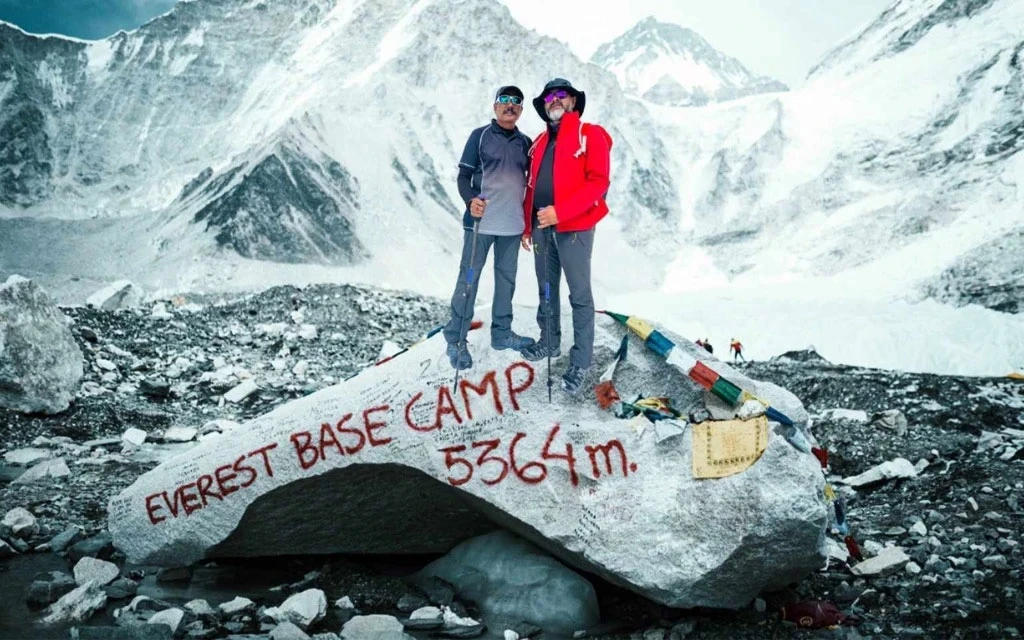
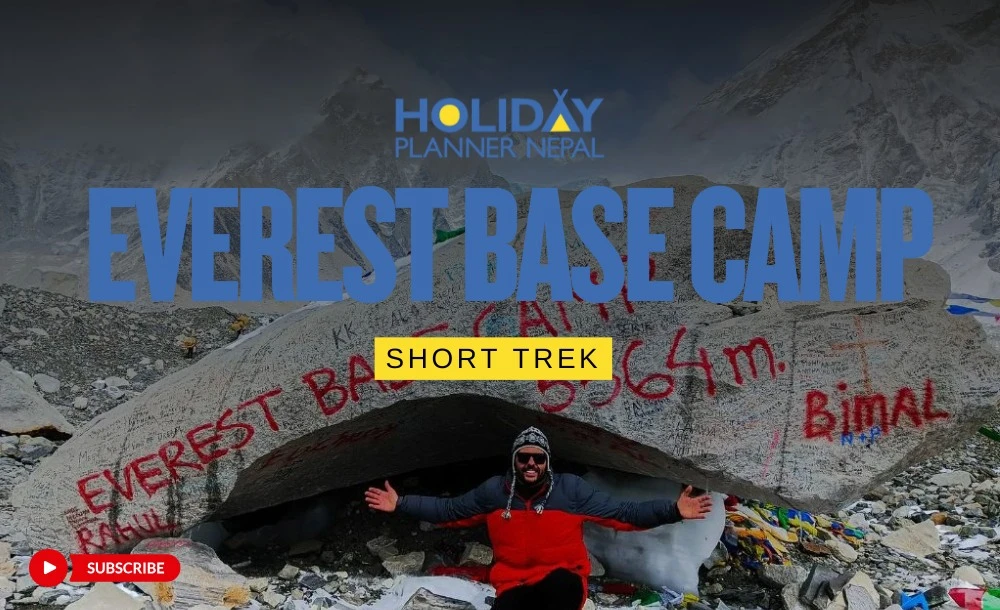

 General
General Upper Body
Upper Body Torso
Torso Lower Body
Lower Body Hands
Hands Feet
Feet Undergarments and Inner Wears
Undergarments and Inner Wears First Aid Kits and Medications
First Aid Kits and Medications Things required for Everest Base Camp trek
Things required for Everest Base Camp trek



